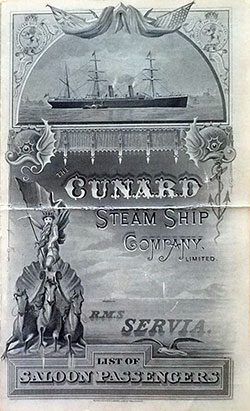Castle Garden Passenger Lists - 1882
Passenger lists for 1882 represent the souvenir list provided to the passengers of each cabin class (and other classes). Many of these souvenir passenger lists have disappeared over the years. Our collection primarily covers North American and European ports and ports in Australia and South Africa.
Our collection contains samples of passenger lists produced and printed by the steamship lines. These lists are often used to illustrate family history books for immigrants from this period.
Coveted by collectors and genealogists, souvenir passenger lists often offered beautiful graphical covers and information not found in official manifests because they focused on the journey rather than the destination.

1882-07-08 RMS Servia Passenger List
Steamship Line: Cunard Line
Class of Passengers: Saloon
Date of Departure: 8 July 1882
Route: Liverpool to New York
Commander: Captain Cook
Please help us make our passenger list collection more complete. We would appreciate a digital copy if you have an 1882 souvenir passenger list. Please email us at history@ggarchives.com.
Recap and Summary of 1882 Castle Garden Passenger Lists
Overview
The year 1882 marked a crucial period in transatlantic migration, with large numbers of European immigrants making the voyage to America through Castle Garden, the primary immigration processing center in New York. Steamships continued to be the dominant mode of long-distance travel, and passenger lists from this period illustrate both the scale and social dynamics of migration.
Steamship companies such as Cunard Line played a vital role in facilitating migration and commercial travel, with vessels like the RMS Servia carrying a mix of wealthy saloon-class travelers and lower-class immigrants seeking new opportunities in the United States. These passenger lists, many of which have been lost over time, remain valuable resources for genealogists and historians.
Notable Voyage of 1882
- RMS Servia (8 July 1882)
- Steamship Line: Cunard Line
- Class of Passengers: Saloon
- Route: Liverpool to New York
- Commander: Captain Cook
- Significance: The RMS Servia was one of Cunard’s most advanced ships of its time, among the earliest transatlantic liners to be constructed with steel rather than iron. This voyage represents the technological advancements that were reshaping ocean travel, allowing for safer and more efficient crossings.
Key Maritime Developments and Historical Context in 1882
- Growing Migration from Europe to the U.S.
- The early 1880s saw a surge in immigration, particularly from Ireland, Germany, Scandinavia, and Eastern Europe. Many migrants were escaping economic hardship, political turmoil, or seeking opportunities in America’s rapidly industrializing cities.
- Castle Garden in New York was processing hundreds of thousands of new arrivals annually, reinforcing its role as the main entry point for immigrants before the opening of Ellis Island in 1892.
- Liverpool, where the RMS Servia departed from, remained one of the busiest departure ports for migrants traveling to America.
- Technological Advancements in Steamship Design
- The RMS Servia, launched in 1881, was one of the first transatlantic liners to be built with steel, making it stronger, safer, and more durable than earlier ships constructed with iron.
- It was also one of the first ships to feature electric lighting, a significant innovation that improved passenger safety and comfort.
- These advancements set the stage for even larger and faster ocean liners in the coming decades, increasing the efficiency of transatlantic crossings.
- The Chinese Exclusion Act (1882) and Its Impact on Migration
- One of the most significant immigration policies of 1882 was the Chinese Exclusion Act, signed into law in May.
- This law suspended Chinese immigration to the U.S. for ten years, marking the first major federal law to restrict immigration based on nationality.
- Although most Chinese immigrants arrived via Pacific ports like San Francisco, the law reflected broader anti-immigrant sentiments that would later influence restrictions on European immigration as well.
- The Role of Castle Garden in Processing Immigrants
- Castle Garden remained the primary immigration processing center in New York, handling the influx of new arrivals and ensuring they were documented.
- Many of the immigrants processed there were from Ireland, Germany, and Scandinavia, seeking jobs in factories, railroads, and agriculture.
- Some wealthier European travelers, such as those in the saloon class aboard the RMS Servia, traveled for business, tourism, or social reasons rather than migration.
- The Competition Among Steamship Lines
- Cunard, White Star, Inman, and other transatlantic shipping companies were competing fiercely to attract passengers, especially wealthier travelers who could afford saloon-class accommodations.
- These companies invested in larger, more luxurious ships, offering better amenities for saloon-class passengers while still accommodating large numbers of steerage-class immigrants.
Conclusion
The year 1882 saw continued growth in transatlantic migration, fueled by industrialization in the United States and economic difficulties in Europe. The RMS Servia, one of the most advanced steamships of its time, represented the future of ocean liner travel, with steel construction and electric lighting making voyages safer and more comfortable.
At the same time, the Chinese Exclusion Act signaled the start of restrictive U.S. immigration policies, foreshadowing future laws that would also impact European migration. The role of Castle Garden remained central to the immigrant experience, processing thousands of new arrivals each month and helping shape the demographic future of America.
With continued innovations in shipbuilding and increasing migration from Europe, 1882 was a defining year in the history of transatlantic travel, setting the stage for even greater changes in the decades to come.
